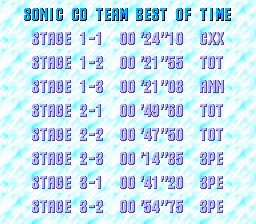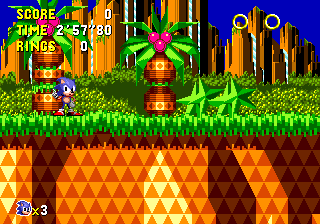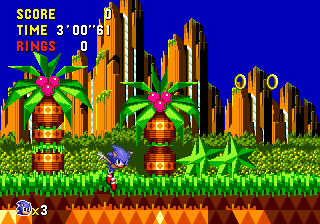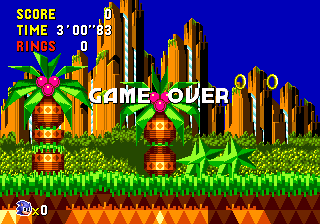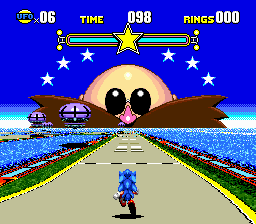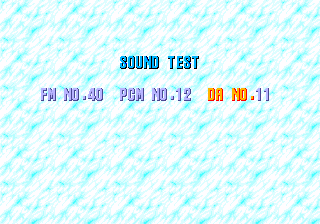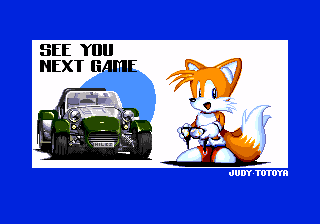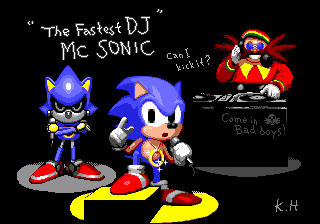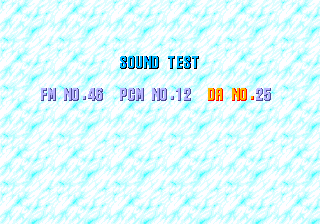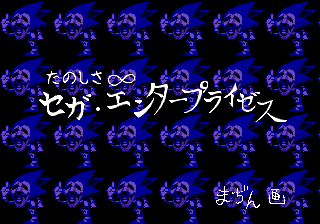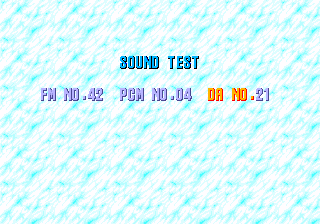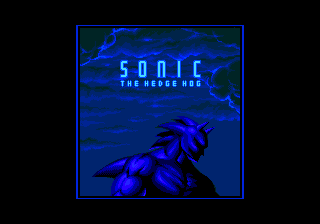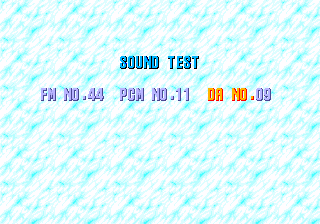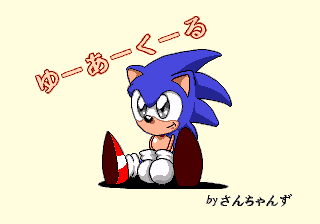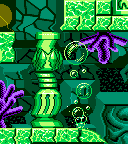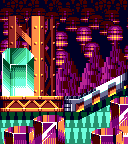Sonic the Hedgehog CD/Hidden content
From Sonic Retro
- Back to: Sonic the Hedgehog CD.
On the title screen, hold ![]() +
+ ![]() and press
and press ![]()
![]()
![]()
![]()
![]()
![]() . You can now use the 2nd controller to move the clouds around.
. You can now use the 2nd controller to move the clouds around.
Pausing the game and then pressing ![]() +
+ ![]() +
+ ![]() will kill Sonic. This is useful if you want to return to the last checkpoint, or if Sonic gets stuck (which can happen easily due to layout differences between time zones).
will kill Sonic. This is useful if you want to return to the last checkpoint, or if Sonic gets stuck (which can happen easily due to layout differences between time zones).
Wait three minutes without doing anything, and Sonic will say, "I'm outta here" and jump off the stage, ending the game.
On sound test screen above, set the values to FM07, PCM07, DA07 and press ![]() .
.
According to a former Sega Europe QA Tester, an extra Time Stone was to be collectable here. When collected in addition to the previous Time Stones, "S" TV monitors would appear where the ring TVs were previously located. When broken, you would morph into a gimped version of Super Sonic, which would simply grant you invincibility and greater speed. The graphics would not change.
On sound test screen above, set the values to FM40, PCM12, DA11 and press ![]() . The image was made by Yasushi Yamaguchi, who created Tails.
. The image was made by Yasushi Yamaguchi, who created Tails.
Tails is pictured next to his favourite car[1], the Lotus Super Seven. While seen in a Sega Saturn test disc, this is the only time to date that it has ever featured in a video game.
Edit mode can also be accessed in the PAL version of the game by pressing ![]() on the second controller when the attraction sequence is playing. The NTSC versions lack this feature (though it is present in the 920 prototype).
on the second controller when the attraction sequence is playing. The NTSC versions lack this feature (though it is present in the 920 prototype).
On sound test screen above, set the values to FM42, PCM03, DA01 and press ![]() . This image was made by Kazuyuki Hoshino.
. This image was made by Kazuyuki Hoshino.
On sound test screen above, set the values to FM46, PCM12, DA25 and press ![]() . The message says たのしさ∞ セガ・エンタープライゼス まぢん画 (Infinite fun. Sega Enterprises - Mazin Picture), and was made by Masato Nishimura.
. The message says たのしさ∞ セガ・エンタープライゼス まぢん画 (Infinite fun. Sega Enterprises - Mazin Picture), and was made by Masato Nishimura.
On sound test screen above, set the values to FM42, PCM04, DA21 and press ![]() . The image was made by Takumi Miyake.
. The image was made by Takumi Miyake.
On sound test screen above, set the values to FM44, PCM11, DA09 and press ![]() . The message says ゆーあーくーる by さんちゃんず (You are cool, by Sanchanzu) and was made by Masahiro Sanpei.
. The message says ゆーあーくーる by さんちゃんず (You are cool, by Sanchanzu) and was made by Masahiro Sanpei.
Contents
Time attack icon oddities
The icons used to denote Tidal Tempest and Quartz Quadrant in the Time Attack menu appear to show earlier versions of these two stages.
Tidal Tempest has ripples in the foreground as well as the background. This is an effect seen in the Japanese version of the original Sonic the Hedgehog, but was removed from subsequent games (including Sonic CD).
Quartz Quadrant has red crystals in the foreground, while in-game the crystals are blue (although they glow a pinky-red).
Unused content
Art
| Description | |
|---|---|
| A sprite of Sonic with his eyes closed. Could have been used as part of an idling animation, akin to Sonic 2's two stages of waiting, and Sonic 3's unused animation of Sonic nodding off to sleep. | |
| An animation of Sonic being shocked by electricity. It may have been used in Wacky Workbench, which contains various level elements with the potential to electrocute the player. It could also have been used in Collision Chaos, as part of the Metal Sonic sequence. | |
| An animation of Sonic falling into the distance. Purpose is unknown. It could have been used for the sequence where an animation of Sonic warping through time is shown. A similar animation was found in Sonic 1 which was also unused. | |
| An animation of Sonic waving his arms with his palms outstretched. This could have been used in Tidal Tempest when walking through the water, to simulate an attempt at moving more quickly. | |
| A sprite of Sonic looking over his shoulder. Most likely to look at Dr. Eggman when he activates his laser behind Metal Sonic prior to the start of the race against Metal in Stardust Speedway Act 3. | |
| An animation of Sonic sneezing. Purpose is unknown. A similar animation can be seen in the opening cartoon where Sonic looks up and then sneezes. It is possible that the moth-like enemies that leave pollen would have caused Sonic to sneeze if he went through the trail of pollen. Possibly this could have caused Sonic to stop suddenly and sneeze, leaving him vulnerable to getting hit by a badnik. | |
| An animation of Sonic upside-down with his eyes wide and his mouth open. This suggests that this animation could have either been used for an alternate death animation, or if Sonic was caught by an environmental hazard that dangles him in the air somehow. | |
| An unused sprite of Sonic grabbing onto something and attempting to create traction. This implies that he may have been trying to stop something from pulling him into some sort of hazard. Part of a scrapped badnik, maybe? A modified version of this sprite appears in Sonic Crackers, as well. | |
| Similar to the other horizontal pole sprites from Wacky Workbench, this one has Sonic swinging his feet forward. Perhaps he originally had to pull away from electrical hazards positioned underneath. | |
| An unused animation of Sonic shrugging his shoulders. These sprites are found in the SPSS__.BIN, which contains Sonic's special stage specific sprites. In the final frames of the animation, the very bottoms of his feet disappear, as though he is sinking into something. Perhaps an unused quicksand hazard, or even being pulled out of the special stage altogether, as a failure to obtain the time stone animation. | |
| An animation of Sonic being pulled up by... something. Purpose unknown. These sprites are also found in the SPSS__.BIN. Early beta shots show hot-air balloons, not UFOs, in the Special Stages. Perhaps they caught Sonic and floated him around? | |
| An animation of Sonic being knocked back. Purpose unknown. These sprites are also found in the SPSS__.BIN. | |
| Purpose unknown. These sprites are also found in the SPSS__.BIN. Perhaps it could have been used for when Sonic jumps on a spring in the special stage? | |
| An unused animation of Sonic with his arms outstretched and his chest pushed out in front of him. Whilst its purpose is unknown, many believe that this is somehow related to transforming into Super Sonic. | |
| An animation of Sonic skidding whilst looking the other way. It is unused in the main game, but does appear during the "You Are Greatest Player!" sequence seen once beating the Time Attack scores. It's fairly similar to the skidding animation in Sonic Crackers, and could have been used while skidding at higher speeds in contrast to the normal skidding animation, which was modified from Sonic 1. | |
| Unused sprites of Amy with hearts in her eyes. Not used at any point in the game. In the Sonic CD 2011 remake, these sprites are utilized whenever Amy hugs Sonic. |
Objects
| Description | |
|---|---|
| Oil slick used in special stages that cause you to slip. These can be found normally in some prototypes of Sonic CD, but are unused in the final game. | |
| An unused broken switch sprite found within the ROM. Speculation shows that they may have been used in the bad future of a zone, to prevent access to certain routes. Other switch sprites for comparison. | |
| An unused platform which moves up and down while moving to the left. It comes in two variations; a pair and a group of four, all of which do the same thing (though in the latter, the top row are flipped vertically). The object belongs to the present version of Quartz Quadrant Zone. | |
| This appears to be an unused item from the special stage. Its use is unknown, but it may have stopped the timer. |
510 prototype
Music loops
Within the ISO image of one of the Sonic CD prototypes were some specific files, preceded with the letters "SNCBNK", with a number afterwards. The numbers referred to the timezone for which the file represented.
Each file is a small music loop, played using the PCM chip of the Sega Mega-CD, according to the timezone it represents. Speculation has been rampant as to their use, but two theories have stemmed that seem to be relatively plausible:
- They were intended to be used to bridge the inevitable gap created when a looping CD audio track rewinds to start again.
- They were intended to be played at the start of a level, before the CD audio played.
The 2011 Sonic CD re-release uses them for loops, so it is highly probable that was what Sega intended to do for the Mega CD version.
These files are available here (info) (1.97 MB), courtesy of ICEknight. Edited files merged with the CD audio tracks by Shadow Hog are available here (info) (33.56 MB). Discussion of this oddity was held in this forum topic.References
| Sonic the Hedgehog CD | |
|---|---|
|
Main page (2011) Manuals |
show;hide
Scrapped Enemies: Scrapped Bosses: Mega-CD: Windows PC:
Books:
Music: |
